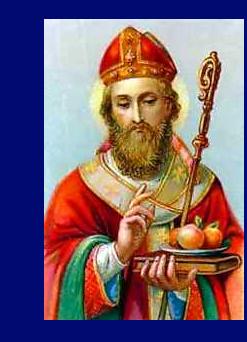|

|
| Saint Nicholas |
Santa Claus
The history of Santa Claus
is as multi-layered, multi-cultural and as fascinating as humanity itself. It all begins with the life of an incredible
man who lived during the dawning of the Christian Era -- Saint Nicholas. Here I have included an excerpt from Wikipedia
on Saint Nicholas, some additional linkage to other sites focusing on the historical "Santa Claus" and some lovely images,
as well. Enjoy.
"Saint Nicholas is the common name
for Saint Nicholas of Myra, who had a reputation for secret gift-giving, but is now commonly
known as Santa Claus. He lived in 4th century Myra in the Byzantine Empire's Lycia, the modern day Demre in the Antaly province of Turkey. This is as much as is generally known
about him in the West.
This historical character was the inspiration for a
mythical figure known as Nikolaus in Germany and Sinterklaas in the Netherlands and Flanders, which in turn was the inspiration for Santa Claus. Sinterklaas (a contracted form of Sint Nicolaas)
is a major celebration in the Netherlands and in Flanders (see below). Among Orthodox Christians, the historical
Saint Nicholas is remembered and revered. Saint Nicholas is the patron saint of sailors, merchants, archers,
children, and students in both Greece and Russia. He is also the patron saint of Barranquilla, Colombia and of Amsterdam.
| Nature's Santa |

|
| By Peggy Abrams |
Nicholas the clergyman
Nicholas of Myra (also Nikolaus)
in Lycia, Asia Minor (lived c. 270 - 345/352), was a 4th century bishop and is a Christian saint. His feast day is December
6, presumably the date of his death. In the Netherlands
5 December is known as his feast: this is Sinterklaasavond, or St. Nicholas' Eve. Among Christians, he is also known as the "Miracle Worker". Several acts of kindness and miracles are attributed to him.
Historical accounts often confuse him with the later Nicholas of Sion.
Nicholas was born in Asia Minor during the 3rd century
at Patara in the province of Lycia, at a time when the region was Hellenistic in its culture
and outlook. Nicholas became bishop of the city of Myra. He was very religious from an early age and devoted his life
entirely to Christianity. He is said to have been born to relatively affluent Christian parents in Patara, Lycia, AsiaMinor, Roman Empire where he also received his early schooling. According to some
sources, his parents died while he was still a child, leaving a paternal uncle to care for him. Other sources place the death
of his parents at the time he was already a young adult, leading him to a period of soul-searching which finally resulted
in his uncle introducing him to Christianity. Whatever the reason, as a young adult and scholar, Nicholas moved to Myra to continue his studies and there the above-mentioned uncle introduced him to the local bishop. The latter is said
to have seen potential in the youth and took Nicholas under his patronage. Nicholas received his ordination as a priest at
an early age.
| Father Christmas |

|
| By Samuel James Carter |
As the patron saint of sailors, Nicholas is claimed to have been
a sailor or fisherman himself. More likely, however, is that one of his family businesses involved managing a fishing fleet.
When his parents died, Nicholas still received his inheritance but is said to have given it away to charity. So was Saint
Nicholas a working, albeit wealthy, man who complemented his day job with caring for his congregation, or was he a full-time
bishop? The impressive list of deeds of Nicholas seems to point to the latter. This does not say, however, that his appointment
to priest or bishop meant a complete rupture with his former life. More likely this was a gradual process.
Nicholas' early activities as a priest are
said to have occurred during the reign of co-ruling Roman
Emperors Diocletian (reigned 284 - 305) and Maximian (reigned 286 - 305) from which comes the estimation
of his age. Diocletian issued an edict in 303 authorising the systematic persecution of Christians across
the Empire. Following the abdication of the two Emperors on May 1, 305 the policies of their successors
towards Christians were different. In the Western part of the Empire Constantius Chlorus (reigned
305 - 306) put an end to the systematic persecution upon his accession to the throne. In the Eastern part Galerius (reigned 305 - 311) continued the persecution until 311 when he issued a general edict of toleration
from his deathbed. The persecution of 303 - 311 is considered to be the longest in the
history of the Empire. Nicholas survived this period although his activities at the time are uncertain."
Continue_reading_about_Saint_Nicholas.
.

|
| By Teresa Kogut |

|
| Jimmy and Jan's Santa |

|

